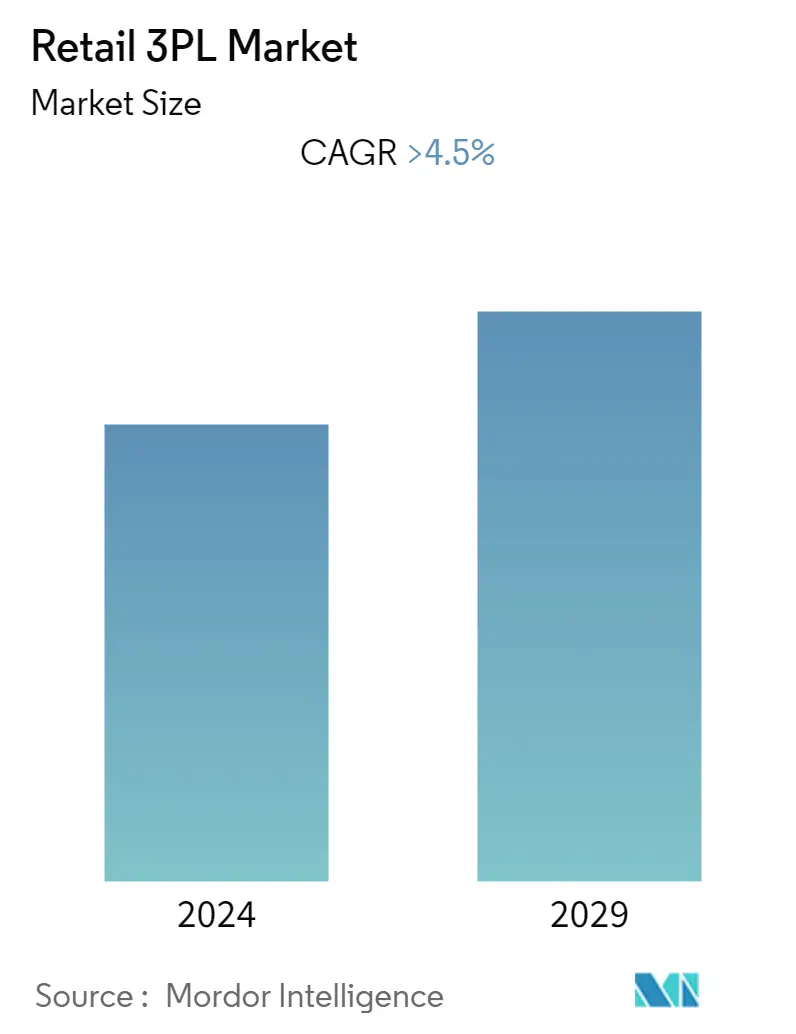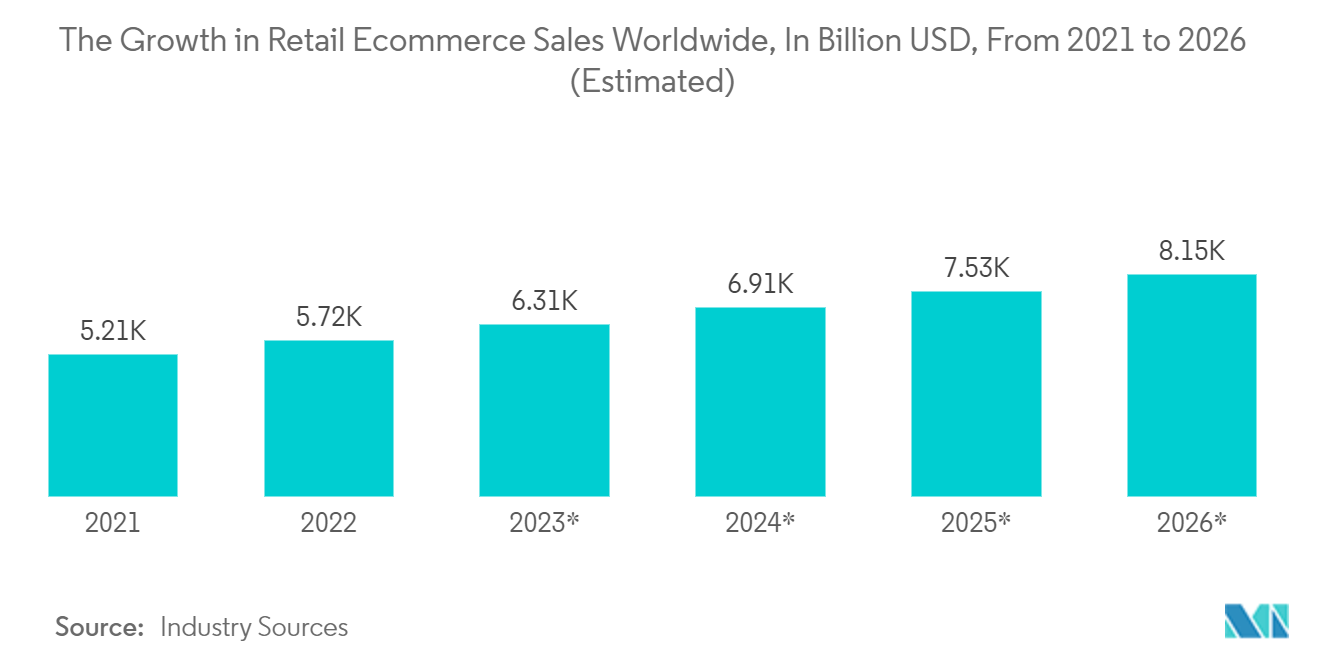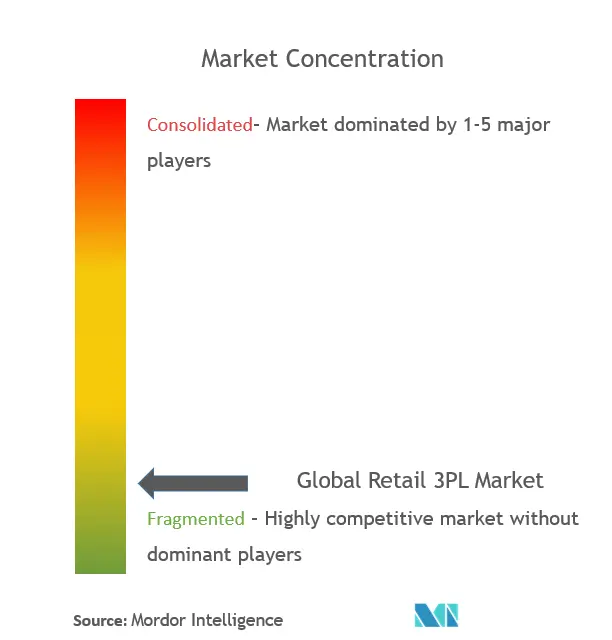Retail 3PL Market Size

| Study Period | 2024 - 2029 |
| Base Year For Estimation | 2023 |
| CAGR | > 4.50 % |
| Fastest Growing Market | Asia Pacific |
| Largest Market | North America and Europe |
| Market Concentration | Low |
Major Players
*Disclaimer: Major Players sorted in no particular order |
Need a report that reflects how COVID-19 has impacted this market and its growth?
Retail 3PL Market Analysis
The Global Retail 3PL Market is valued at about USD 455 billion and is expected to register a CAGR of more than 4.5% during the forecast period. The report offers the market sizes and forecast for the Global 3PL Market in value (USD billion) for all the above segments.
- The growth of the logistics services market is anticipated to be bolstered during the analysis period by the expanding e-commerce sector and the rising need for speedy delivery among customers globally. In addition, the expanding inventory management policy is anticipated to increase the need for logistic services across a variety of industries, which is expected to support market expansion throughout the projected period. In addition, more people are embracing contemporary technology like artificial intelligence. During the projected period, the industry is anticipated to see tremendous development prospects thanks to technologies like machine learning and blockchain. The lack of adequate infrastructure and logistics professionals, however, could limit market expansion for the duration of the predicted timeframe.
- A growing trend in the US 3PL business is the use of blockchain technology in the logistics sector. A digital platform called blockchain technology provides a distributed transaction ledger. The stakeholders' multiple computer systems can readily keep identical copies of the ledger. The blockchain, in general, is a system that uses a thread of records that are cryptographically protected and detail all transactions for all parties involved in the supply chain. Using blockchain technology, a reliable and cost-effective supply chain may be created.
- Inflation will cause a 5% increase in worldwide retail sales in US dollars in 2023, but decreased sales volumes and rising prices will hurt retailers' profits. In 2023, retailers' profits will be constrained by 6.4% worldwide inflation and flat demand. They will have to deal with growing labour and energy costs in addition to increased raw material and logistical costs. Retail salaries have increased more quickly than average private-sector wages in several nations, particularly in Europe, where wholesale electricity tariffs have also increased.
- 86% of consumers buy products in physical stores and online, while 14% do so only occasionally, according to Neilsen IQ. Less than 1% of consumers only make internet purchases. Omnichannel is a persistent and significant fixture of consumer behaviour, far from being a fad. Globally, 30% of customers said their priorities have entirely changed, impacting their purchasing behaviour, and 59% are reassessing their priorities. In the United States, 81% of customers are changing their priorities or already doing so.
Retail 3PL Market Trends
Asia-Pacific Region Driving the Market
Asia is the world's most populous continent, and China and India account for the majority of e-commerce transactions. E-commerce is a primary driver of third-party logistics growth. Due to the increased use of logistics across numerous industries, including as e-commerce, construction, retail, automotive, food & beverage, and hospitality, the Asia-Pacific third-party logistics industry is booming. During the forecast period, the Asia-Pacific third-party logistics market is anticipated to benefit from the introduction of technological advancements such as transportation management systems, supply chain management, international trade logistics systems, and enterprise resource planning in the logistics industry.
The Asia-Pacific third-party logistics market is seeing significant expansion driven by the rising e-commerce industry. China is currently the largest exporter of goods and the centre of the global manufacturing industry. The largest markets in the e-commerce sector are also rising in other nations, like Japan and India. In order to acquire a competitive edge, the major market participants, such as Amazon, Alibaba, and Rakuten, are concentrating on enhancing their customer service by providing same-day delivery and simple returns. The infrastructure for logistics services is also being developed by the companies, which is expected to drive the Asia-Pacific third-party logistics market over the forecast period.
In the Asia-Pacific area, DHL International GmbH (a subsidiary of Deutsche Post AG) is the market leader with an estimated market share of between 2% and 7%. Through their third party logistics services, which include express services, supply chain solutions, warehousing & distribution, and freight transportation, the company has achieved remarkable sales.

Growth in E-commerce
In 2023, it is anticipated that the worldwide e-commerce market would reach USD 5.7 trillion. It is anticipated that this number will increase over the next years, demonstrating how valuable borderless e-commerce is turning out to be for online merchants. Only 17.8% of sales two years ago came from online purchasing. The e-commerce market share is anticipated to expand by 2 percentage points to 20.8% in 2023 from the current figure. Growth is anticipated to continue, with a projected peak of 23% by 2025 a rise of 5.2 percentage points in just five years. Retail market share will increase as global retail sales growth keeps rising. By 2023, eMarketer and Statista's study projects that online retail sales will amount to USD 6.51 trillion, with e-commerce websites accounting for 22.3% of all retail sales. With 46.3% of all retail e-commerce sales globally and slightly over USD 2.8 trillion in total online sales in 2022, China will continue to dominate the global e-commerce sector. Additionally, it has 842.1 million digital purchasers, or 39.4% of all digital customers worldwide, making it the largest market. In 2022, the US e-commerce market is anticipated to grow to more than USD 904.9 billion, slightly more than China's. With 4.8% of the retail e-commerce sales share, the United Kingdom is the third-largest e-commerce market after China and the US. Japan (3%) and South Korea (2.5%) are the nations that come after the UK.

Retail 3PL Industry Overview
The global retail 3PL market is fragmented in nature with a mix of global and local players. Some of the strong players include DSV Panalpina, DHL, Ceva Logistics, Ryder Supply Chain Solutions, C.H. Robinson, and Hub Group. Despite the restrictions and lockdowns in place around the world, governments in 2020 allowed trucks to commute at night to meet the country's internal demands, causing severe disruption in the third-party logistics industry. As the market grew due to the development of e-commerce, new third-party logistics companies began to enter the market.
Retail 3PL Market Leaders
DSV Panalpina
Kuehne + Nagel
C.H. Robinson
DHL Supply Chain & Global Forwarding
UPS Supply Chain Solutions
CEVA Logistics
*Disclaimer: Major Players sorted in no particular order

Retail 3PL Market News
April 2023: The CMA CGM Group announced that it has entered into exclusive negotiations to acquire the transportation and logistics activities held through Bolloré Logistics. The negotiations are in line with the CMA CGM Group's long-term strategy, based on the two pillars of shipping and logistics. The Group's strategy is to offer end-to-end solutions in support of its customer's supply chain needs. If a deal is reached, the acquisition would further strengthen the CMA CGM Group logistics activities.
March 2023: DSV to acquire US-based transport and logistics companies S&M Moving Systems West and Global Diversity Logistics. These acquisitions will strengthen DSV's position within the semiconductor industry, align with its new Phoenix-Mesa Gateway Airport operations and support DSV's growing cross-border services to Latin America. The transactions are expected to be completed in April 2023, pending all legal formalities.
Retail 3PL Market Report - Table of Contents
1. Introduction
1.1 Study Deliverables and Assumptions
1.2 Scope of the Study
2. Research Methodology
2.1 Analysis Methodology
2.2 Research Phases
3. Executive Summary
4. Market Dynamics And Insights
4.1 Current Market Scenario
4.2 Market Dynamics
4.2.1 Drivers
4.2.2 Restraints
4.2.3 Opportunities
4.3 Value Chain / Supply Chain Analysis
4.4 Industry Policies and Regulations
4.5 General Trends in the Warehousing Market
4.6 Demand From Other Segments, such as CEP, Last Mile Delivery, Cold Chain Logistics, Etc.
4.7 Insights on E-commerce Business
4.8 Technological Developments in the Logistics Sector
4.9 Industry Attractiveness - Porter's Five Forces Analysis
4.10 Impact of COVID-19 on the Market
5. Market Segmentation
5.1 By Product
5.1.1 Foods and Beverages
5.1.2 Personal and Household Care
5.1.3 Apparel, Footwear, and Accessories
5.1.4 Furniture, Toys, and Hobby
5.1.5 Electronic and Household Appliances
5.1.6 Other Products
5.2 By Distribution Channel
5.2.1 Supermarkets/Hypermarkets, Convenience Stores, and Department Stores
5.2.2 Specialty Stores
5.2.3 Online
5.2.4 Other Distribution Channels
5.3 By Geography
5.3.1 Asia-Pacific
5.3.1.1 China
5.3.1.2 Japan
5.3.1.3 India
5.3.1.4 South Korea
5.3.1.5 Rest of Asia-Pacific
5.3.2 North America
5.3.2.1 United States
5.3.2.2 Canada
5.3.2.3 Mexico
5.3.3 Europe
5.3.3.1 United Kingdom
5.3.3.2 Germany
5.3.3.3 France
5.3.3.4 Russia
5.3.3.5 Rest of Europe
5.3.4 Middle-East and Africa
5.3.4.1 Saudi Arabia
5.3.4.2 United Arab Emirates
5.3.4.3 Qatar
5.3.4.4 South Africa
5.3.4.5 Rest of Middle-East and Africa
5.3.5 Latin America
5.3.5.1 Chile
5.3.5.2 Brazil
5.3.5.3 Mexico
5.3.5.4 Argentina
5.3.5.5 Colombia
5.3.5.6 Rest of Latin America
6. Competitive Landscape
6.1 Market Concentration Overview
6.2 Company Profiles
6.2.1 DSV Panalpina
6.2.2 Ceva Logistics
6.2.3 Ryder Supply Chain Solutions
6.2.4 C.H. Robinson
6.2.5 Hub Group
6.2.6 D.B. Schenker
6.2.7 J.B. Hunt
6.2.8 Echo Global Logistics
6.2.9 UPS Supply Chain Solutions
6.2.10 Knight Transportation
6.2.11 Nippon Express
6.2.12 Kerry Logistics
6.2.13 DHL Supply Chain
6.2.14 Kuehne + Nagel
6.2.15 CJ Logistics
6.2.16 Expeditors*
- *List Not Exhaustive
7. Future of the Market
Retail 3PL Industry Segmentation
Third-party logistics, often known as 3PL, is a system in which a company offers inventory management and delivery services to another company. A 3PL company is frequently used by a company (client) that does not have its own logistics department. In turn, the 3PL takes care of some or all of the client's logistics needs. The global retail 3PL market is segmented By Product (Foods and Beverages, Personal and Household Care, Apparel, Footwear, and Accessories, Furniture, Toys and Hobby, Electronic and Household Appliances, and Other Products), Distribution Channel (Supermarkets/Hypermarkets, Convenience Stores, and Department Stores, Specialty Stores, Online, and Other Distribution Channels), and Geography (Asia-Pacific, North America, Europe, Middle-East and Africa, and Latin America). The report offers market size and forecasts for the Global Retail 3PL Market in Value (USD Billion) for all the above segments. It also covers a comprehensive background analysis of the Global Retail 3PL Market, covering the current market trends, restraints, technological updates, and detailed information on various segments and the industry's competitive landscape. The report offers the market sizes and forecast for the Global 3PL Market in value (USD billion) for all the above segments.
| By Product | |
| Foods and Beverages | |
| Personal and Household Care | |
| Apparel, Footwear, and Accessories | |
| Furniture, Toys, and Hobby | |
| Electronic and Household Appliances | |
| Other Products |
| By Distribution Channel | |
| Supermarkets/Hypermarkets, Convenience Stores, and Department Stores | |
| Specialty Stores | |
| Online | |
| Other Distribution Channels |
| By Geography | ||||||||
| ||||||||
| ||||||||
| ||||||||
| ||||||||
|
Retail 3PL Market Research FAQs
What is the current Global Retail 3PL Market size?
The Global Retail 3PL Market is projected to register a CAGR of greater than 4.5% during the forecast period (2024-2029)
Who are the key players in Global Retail 3PL Market?
DSV Panalpina, Kuehne + Nagel, C.H. Robinson, DHL Supply Chain & Global Forwarding, UPS Supply Chain Solutions and CEVA Logistics are the major companies operating in the Global Retail 3PL Market.
Which is the fastest growing region in Global Retail 3PL Market?
Asia Pacific is estimated to grow at the highest CAGR over the forecast period (2024-2029).
Which region has the biggest share in Global Retail 3PL Market?
In 2024, the North America and Europe accounts for the largest market share in Global Retail 3PL Market.
What years does this Global Retail 3PL Market cover?
The report covers the Global Retail 3PL Market historical market size for years: . The report also forecasts the Global Retail 3PL Market size for years: 2024, 2025, 2026, 2027, 2028 and 2029.
Global Retail 3PL Industry Report
Statistics for the 2024 Retail 3PL market share, size and revenue growth rate, created by Mordor Intelligence™ Industry Reports. Retail 3PL analysis includes a market forecast outlook to for 2024 to 2029 and historical overview. Get a sample of this industry analysis as a free report PDF download.
